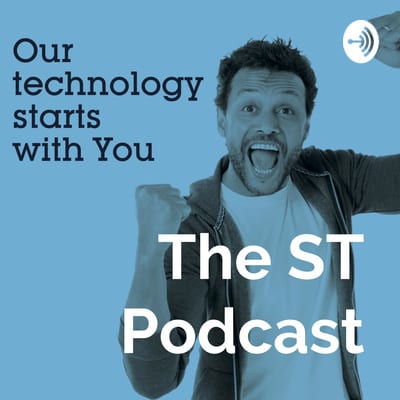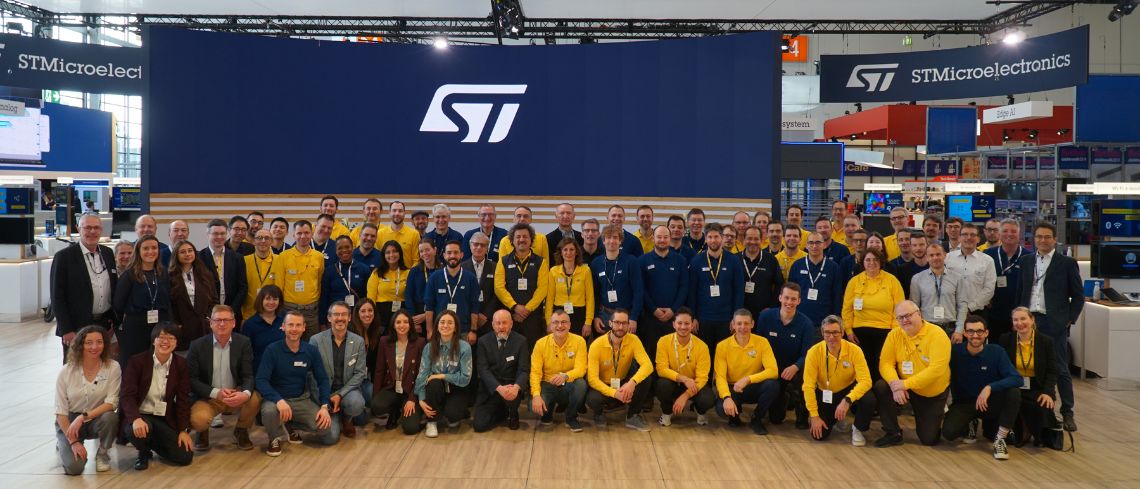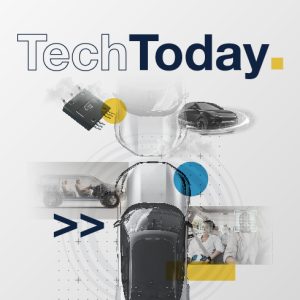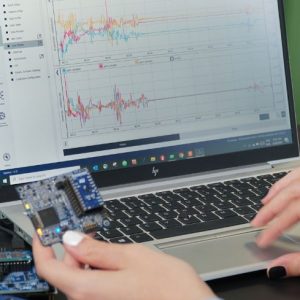Every year we bring new innovations and products to our events. Two weeks ago, we were at Embedded World in Nuremberg, which took place from 11 to 13 March 2025. At our booth, more than 45 demos were presented in the following areas: STM32 MCUs, Cybersecurity, RF connectivity, Power and analog, Edge AI, Sensing, Automotive. Visitors at our booth were able to ask questions to our experts, take part in speaking sessions and grow their network.
In addition, ST continues its commitment to sustainability. We collaborated with the Verified Carbon Standard (VCS), a worldwide standard, to guarantee certification and recognition of our carbon offsetting. We fully carbon compensated our participation in embedded world 2025 by funding projects (like reforestation initiatives) that either reduce or capture a quantity of carbon commensurate with the carbon produced from our event participation.
ST solutions: new products and advancements
Among the demos presented at the event there are some that we have already discussed in the blog such as STM32N6, STM32U3, STM32WBA6, STM32C0, STM32WL3, STM32MP2X, Touch GFX and STM32 graphic solutions, Edge AI ecosystem, Teseo VI, and Biosensors, including heart rate and ECG with SensorTile.box PRO, MEMS Studio and ST evaluation kits.
Other solutions have not yet been presented to our readership and among these there are STM32Cube VS Code, Post Quantum Cryptography, New NFC readers, Ethernet-on-Ring MCU, and some interactive demos such as the impact intensity one (using the LSM6DSV80X IMU) and a robotized table soccer.
STM32Cube VS Code ecosytem: Lightweight, fast and flexible
With the VS Code ecosystem ST aims to provide lightweight, fast and powerful coding tools for the STM32 portfolio. The first step of this journey is to unlock updateability by a complete architectural redesign. A traditional embedded IDE consists of a GUI, some CLI tools and MCU SDKs. Our new solution completely decouples these three aspects. This will allow ST to develop and maintain each of the aspects faster and our customers will be able to select only the features and updates they want. Features and bug fixes will be deployed on a monthly basis.
Key features include:
- RTOS aware debug for FreeRTOS and ThreadX, full thread call stacks and kernel object information.
- ST clang support, a new ST developed LLVM-based toolchain that will be supported inside VS Code.
- A new build analyzer feature to help users analyze the memory footprint of the application.
Post-Quantum Cryptography: smart and future-proof
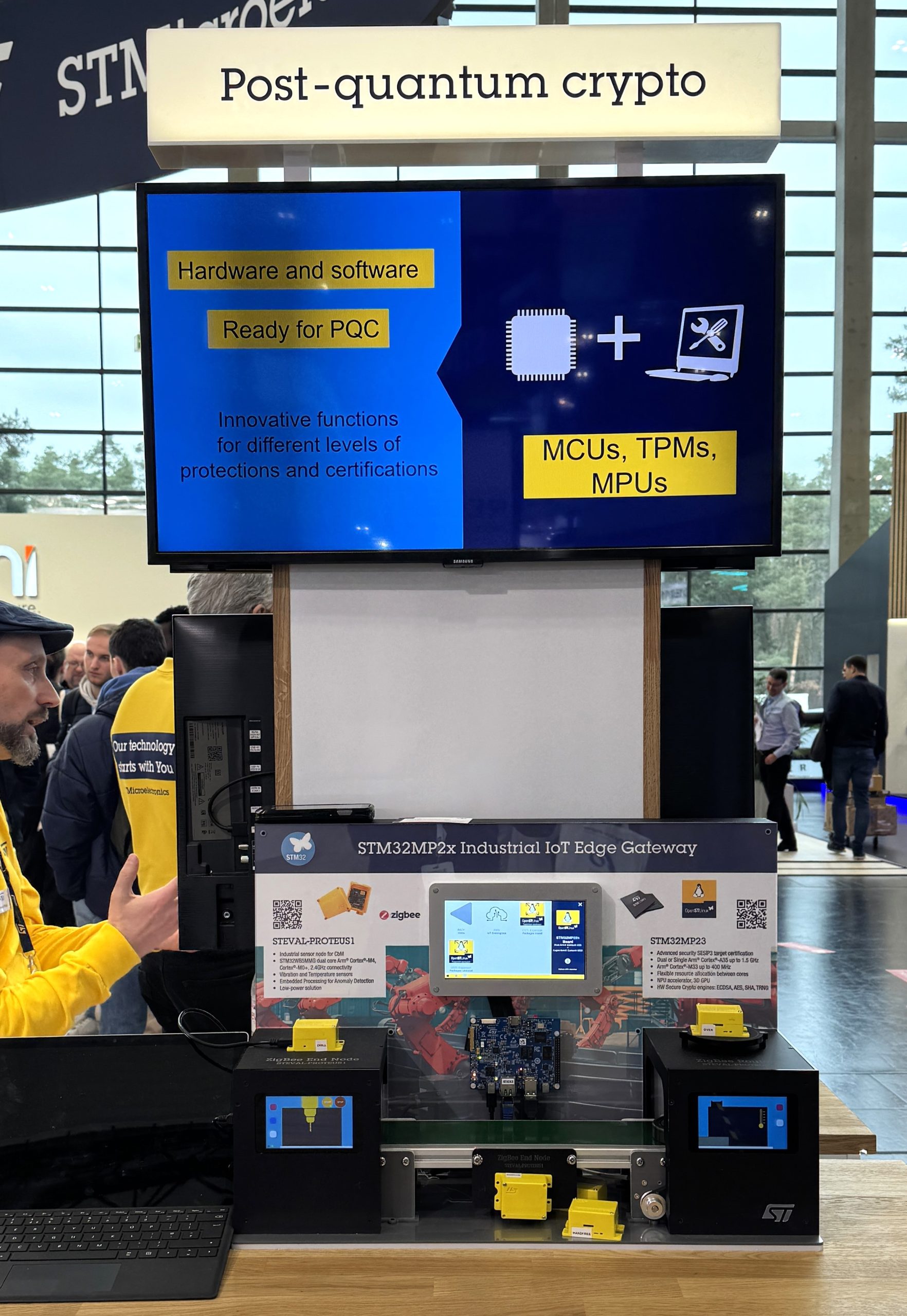
At this demo pod visitors could experience a real end-to-end Post-Quantum Cryptography (PQC) demonstration with AWS Cloud. The demo is based on a secure communication exchange between an STM32MP23 using AWS Key Management Service (KMS) to enforce a PQC Key Exchange Mechanism (NIST adopted ML-KEM algorithm).
Key features include native implementation of ML-KEM in the STM32MP23, real-time connection to the AWS PQC server and implementation of AWS IoT Greengrass. For post quantum cryptography ST offers both a software and a hardware implementation, depending on the product and on the level of security users need to achieve.
New NFC Readers: for consumer, payment terminals, industrial and automotive applications
The demo showcases our new generation of NFC/RFID readers, with enhanced detection capabilities for long-range applications, surpassing our previous generation readers. Also, with an output power of 2.2 W, it ensures better performance and reliability. It’s also part of our 10 years longevity program, ensuring long-term availability and reliability with in-house production.
The demo includes the new ST25R300 for consumer and industrial applications. This high-performance universal NFC device provides wakeup range and robustness for applications from contactless payment to wireless charging and product traceability. It also offers very high-power output and extended range capabilities, allowing designers the freedom to use compact antenna components without compromising performance.
It can be used for payment terminal applications, and it is fully compliant with the EMVCo 3.1 standard. This compliance ensures that the product can be seamlessly integrated into POS payment terminals, providing secure and efficient contactless payment solutions, even when the reader’s antenna is located behind an LCD screen, thanks to its noise suppression receiver feature.
For automotive applications users can rely on ST25R500 & ST25R501, belonging to the ST25R line up, which are our newest high-performance automotive readers. During EW25 we also presented a smart lock use case, highlighting the enhanced communication capabilities with a smartphone as a digital key. The communication and authentication are secured by the STSAFE-A120 secure element, ensuring a high level of security for access control applications.
Ethernet-on-Ring MCU Demo: Fail-Safe Automotive Solution
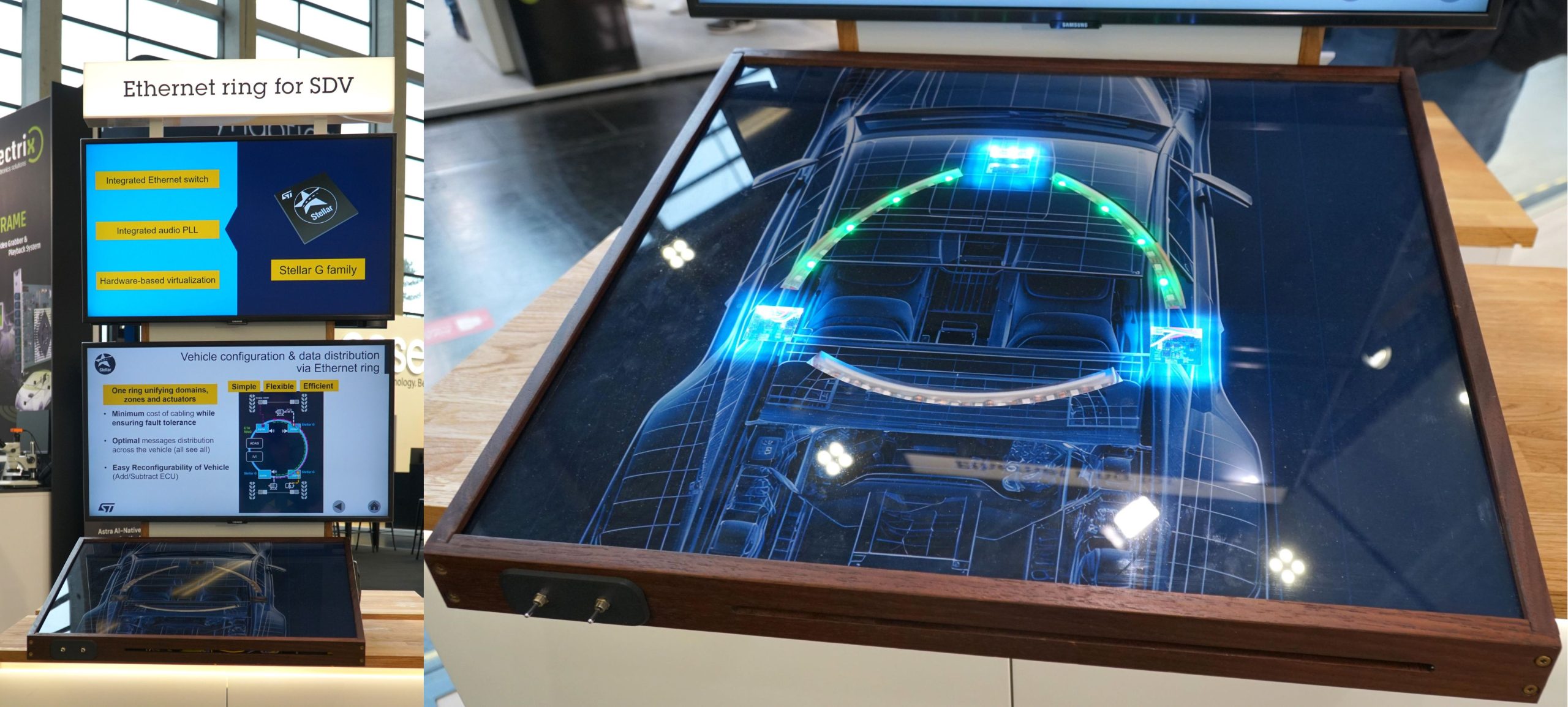
The Ethernet ring topology offers numerous advantages for software-defined vehicles, thanks to ST’s Stellar G Integration MCU. It also offers a higher level of fail-safe than the star architecture. This architecture supports high bandwidth and low latency, ensuring efficient data transmission across the vehicle.
The cost of cabling is minimized while ensuring fault tolerance and optimal message distribution across the vehicle. This setup allows for easy reconfigurability, as the user can add or remove Electronic Control Units (ECUs) when needed. In case one Ethernet cable becomes loose or breaks, this technology allows transmission of information on the other side of the ring to the final microcontroller, ensuring fail-operational functionality.
The SR6G6 Integration MCU features Ethernet AVB, media clock recovery, and integrated audio PLLs. It includes two I2S/TDM interfaces and an integrated Sample Rate Converter (SRC) with six channels, facilitating transmission of audio or video information over the Ethernet link. It also provides Quality of Service (QoS) and advanced security protocols, making it easy to debug and access from anywhere.
LSM6DSV80X: accurate measurement of impact intensity in soccer
This demo shows a simulation of impact intensity monitoring (acceleration profile) in soccer when a player hits the ball. It allows not only traditional motion detection but also measurement of the impact intensity.
The SensorTile.box PRO hosts the LSM6DSV80X extension board and the setup is integrated into a device worn by the player. The sensor is still in the same package (size 2.5 x 3 mm) as all ST traditional IMUs. Features include a new 16g/80g dual-range IMU LSM6DSV80X, Edge AI processing with MLC and support of FSM/ASC/SFLP and sport training analysis at application level.
How to play table football against a robot?
This eye-catching demo invites visitors to challenge a robotized table soccer, that is powered by Edge AI. The system integrates mechanical, electronic and software components all coordinated by a vision system that tracks the ball. Eight BLDC (brushless) motors control the translation and rotation of the poles, ensuring dynamic gameplay. The system also displays scores, demo status, and statistics.
The demo can recognize and track the ball during the game through a vision system based on VD66GY sensor. AI-based strategy using trajectory prediction and pole target positions are implemented by STM32MP257F-DK, while the fast reaction to follow and kick the ball is enabled by motors and related driver boards STEVAL-ETH001V1.
- Watch event highlights on our Youtube channel
- Discover more on our biosensors
- Learn more on the STM32U3, the first STM32 with a 0.65 V VCORE
